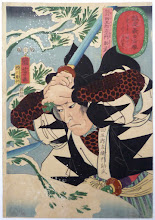Why don't we see more about the influences and inspiration of the classic fairy tales in fantasy RPGs?
The basics are there: common folk (often young) end up meeting with supernatural monsters, and often defeat them through cleverness or persistence. Treasure sometimes is picked up along the way.
I know there have been some attempts at 'fairy tale' RPGs, and some people have had success running fairy tale themed games with D&D or other fantasy RPGs. But why don't we hear more about it? Is it some childish desire to make the game seem more 'mature'?
These fairy tales, along with mythology and the Medieval romance, are what informed the Pulps AND the literature that informed D&D. Both Frodo and Fafhrd owe a debt to Jack the Giant Killer and Hansel and Gretel.
Frightful Fridays! Thornet
1 hour ago






Fairy tales usually have a definite ending (for good or bad) and are perhaps too well known to incorporate the unexpected?
ReplyDeleteAlso, many of the stories aren't particularly glued to a specific setting (Hansel and Gretel aren't in a particular forest...)
That's all I got... You present an excellent question - perhaps we need an 'FT' series of modules?
I try to put a little "fairy tale" in the material I write, but it is difficult to write "story" into a game without making it decidedly less "old school", and the setting of fairy tales varies widely. Still, I think you can inject "fairy tale" pretty successfully with the juxtaposition of innocence and evil, and by putting a sense of wonder into the way you describe things.
ReplyDeletePersonally, I'm not so much concerned with how to get a 'fairy tale' feel in games, so much as wondering why we gush over stuff like REH, HPL, JRRT, Vance, Anderson, Leiber, and to a lesser extent Classical and Norse mythology, the Matters of Britain and France, etc. as influences in our games.
ReplyDeleteWe overlook the Brothers Grimm and H.C. Andersen at the same time.
Trolls under bridges, giants living on clouds, wicked witches in the woods, the big bad (were)wolf, that sort of stuff is in the game, but we rarely pay heed to the source material. Just wondering why.
I think in lot of ways, all sorts of source material gets "smoothed over" as its gami-fied.
ReplyDeleteThere's more talk of games emulating all those sources you mention than actual games that do--though I will grant you in each case at least one has existed.
It's a matter of preference, at least in my case. I've never been drawn to the fairy tale stuff the way I am to Conan and that type of adventure. As for the fairy tale elements already in the game, that's because D&D has had many contributors, and just about everything has been crammed into D&D at some point. Just because it is in the books doesn't mean we must use it all, or even like those elements. If people liked it, or used it in their own games, we'd address it more. It's that simple. It should also be noted that 4th edition has removed the "fairy tale" type monsters and things and the reasoning was that it is incompatible with the style of adventure D&D does well. I actually agree.
ReplyDeleteI posted along similar lines last month (fairy tale inspirations). As to why we don't see more fairy tale elements in D&D, getting your players to operate with the logic of children ("transform contiguity into causality") would be one hurdle.
ReplyDeleteI love me some fairy tales, from the creepy Brothers Grimm originals (not those whitewashed Disney hatchet jobs) to the creepy Guillermo Del Toro Pan's Labyrinth stuff.
ReplyDeleteThe reason we don't see more fairy tale influence in gaming is that D&D and other systems are reliant upon violence as a resolution to conflict, rather than wit and trickery.
That said, one game that I have been looking at is Adventures in Oz. Not classicly fairytale but I'm interested to see how it handles non-violent conflict.